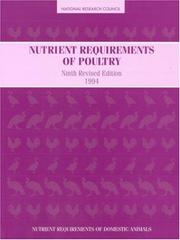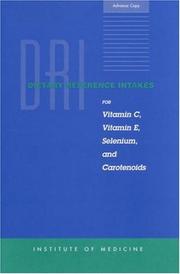| Listing 1 - 6 of 6 |
Sort by
|
Book
ISBN: 9781441971883 Year: 2011 Publisher: New York NY Springer New York
Abstract | Keywords | Export | Availability | Bookmark
 Loading...
Loading...Choose an application
- Reference Manager
- EndNote
- RefWorks (Direct export to RefWorks)
The following chapters provide excellent and comprehensive discussions of the potential role of vitamin D based therapies in breast, colorectal, prostate cancer and leukemia and myelodysplastic syndromes. These chapters also point out that the focus on these diseases is largely determined by the interests and expertise of the outstanding scientists who have chosen to pursue vitamin D based cancer therapeutics. To our knowledge, every tumor type ever evaluated has shown some biochemical and antiproliferative response to vitamin D. Similarly, vitamin D analogues, especially calcitriol, potentiate almost every cytotoxic agent with which combination therapies have been tested.
Nutritionary hygiene. Diet --- Pharmacology. Therapy --- Oncology. Neoplasms --- vitamine D --- farmacologie --- toxicologie --- voedingsleer --- oncologie
Multi
ISBN: 9789086867653 9789086862108 9086867650 Year: 2013 Publisher: Netherlands : Wageningen Academic,
Abstract | Keywords | Export | Availability | Bookmark
 Loading...
Loading...Choose an application
- Reference Manager
- EndNote
- RefWorks (Direct export to RefWorks)
Research and clinical application of vitamin D has increased dramatically over the past decade stimulated by novel health promotion discoveries and documentation. This book brings together key researchers with their views focusing on the health promotion role of vitamin D. Such information is vital to clinicians, users of vitamin D supplements of all ages and those interested in public policy. The authors document and define many of the key health related roles of vitamin D. Its traditional application in bone and muscle health as well as therapy of arthritis is expanded and clarified with new research. A better understanding of the effects of vitamin D inadequacy is modelled using problems ranging from infant growth retardation to chronic kidney and periodontal disease. Uniquely the vitamin?s role in resistance and treatment of infectious diseases is shown in examples ranging from HIV/AIDS to tuberculosis. Mechanistic understanding of vitamin D's actions is enhanced by looking into its effects on immune modulation and inflammation. Expansion of the role of sunlight in stimulating vitamin D production is discussed relative to the reduction in a variety of cancers. Clearly vitamin D is like a two edged sword with great benefits but also some risks. This book provides carefully defined examples of both situations.
Biology --- vitamine D --- biologie --- besmettelijke ziekten --- artritis --- Vitamin D. --- Vitamin D deficiency.
Book
ISBN: 9781617798887 Year: 2012 Publisher: Totowa NJ Humana Press Imprint Humana Press
Abstract | Keywords | Export | Availability | Bookmark
 Loading...
Loading...Choose an application
- Reference Manager
- EndNote
- RefWorks (Direct export to RefWorks)
Vitamin D deficiency is a worldwide problem and many associations with diseases are being discovered. Recently, there has been an interest in the role that vitamin D plays in the inception and progression of lung disease. Vitamin D and the Lung: Mechanisms and Disease Associations delivers a concise, evidence-based review of the evidence for a role of vitamin D in various lung disorders. Divided into three sections, the first section of the book delivers a review of how vitamin D deficiency emerged in human populations, and gives a perspective on how humans evolved to maximize the efficiency of production of vitamin D. The second section of the book reviews aspects of vitamin D mechanisms on different immune cells, lung tissue, and genetics that have potential impact on lung disease. The third section follows with chapters on associations of vitamin D with the risk for viral infections, asthma and allergies, chronic obstructive pulmonary disease, cystic fibrosis, tuberculosis, and finally, lung cancer with an emphasis on ongoing research and clinical issues and needs for future research in each field. Written by an international group of expert authors, Vitamin D and the Lung: Mechanisms and Disease Associations is an essential text for researchers in the respiratory field and practicing clinicians including internists, pulmonologists, and primary care personnel.
Physiology of the respiratory system --- Nutritionary hygiene. Diet --- Orthopaedics. Traumatology. Plastic surgery --- Human medicine --- vitamine D --- geneeskunde --- spoedgevallen --- pneumologie --- parenterale voeding --- sondevoeding --- EHBO (eerste hulp bij ongelukken) --- dieetleer
Book
ISBN: 9053509003 Year: 1999 Publisher: Leuven Apeldoorn Garant
Abstract | Keywords | Export | Availability | Bookmark
 Loading...
Loading...Choose an application
- Reference Manager
- EndNote
- RefWorks (Direct export to RefWorks)
Dit boek gaat over voedingsmiddelen die voor een welbepaald doel, een welomschreven doelgroep zijn bestemd: afslankers, sportbeoefenaars, zuigelingen en kleuters, bejaarden... Het beschrijft vooral de samenstelling, eigenschappen en toepassingen van deze middelen en producten.De eerste 3 hoofdstukken gaan over normale voeding waarbij het belang van een aangepaste voeding voor een goede gezondheid en optimale levensstijl uitdrukkelijk wordt aangeduid. Bijzondere aandacht gaat naar verband tussen voeding en welvaartsziekten, zoals atherosclerose en kanker. Een apart hoofdstuk behandelt de wetgeving omtrent voedingsmiddelen. Daarna komen de verschillende categorieën van nutriënten aan de orde en de bijzondere voeding die ermee verband houdt (vb. eiwitrijke voeding bij anorexie, eiwitarme bij nierlijders). Een volgende reeks hoofdstukken is gewijd aan producten voor specifieke bevolkingsgroepen. Vermageringsproducten krijgen een afzonderlijk hoofdstuk, net als de nieuwe trend: nu
Nutrition --- Dutch. --- dieet --- dieetleer --- voedingsleer --- sport --- Nutritionary hygiene. Diet --- baby's --- kleuters --- vermageringsdieet --- voedingshygiëne --- bejaarden --- 628.4 --- babyvoeding --- dieetvoeding --- vitaminen --- Dieetleer --- 613.2 --- Babyvoeding (zuigelingenvoeding) --- Voeding --- voedingshygiëne (voedingsgewoonten) --- Dieet --- Kindervoeding --- vetten --- Vitaminen (l-carnitine) --- Voedingsleer --- koolhydraten --- eiwitten --- dieet (diëtetiek) --- sondevoeding (enterale voeding) --- parenterale voeding (TPN) --- borstvoeding --- flesvoeding --- obesitas (vermageringsdieet) --- 628.44 --- Diététique --- Voedingsleer. Dieet --- Alimentation/Nutrition --- (zie ook: voedingshygiëne) --- (zie ook: lactatie) --- Voedingsmiddelen --- Gezondheidszorg --- Epidemiologie --- Wetgeving --- Ziekten --- Voedseladditieven --- Sport --- Bejaarden --- Kleuters --- Vitaminen --- Eiwitten --- Vetten --- Koolhydraten --- Mineralen --- Baby's --- Vermageren --- Diëten --- Voedingsmiddel --- Ziekte --- Voedingsadditief --- Oudere --- Kleuter --- Vitamine --- Proteïne --- Vet --- Koolhydraat --- Mineraal --- Baby --- Vermagering --- Onderzoek --- Ontwikkeling --- Leerlijn --- Gemeenschap --- School --- Buurt --- Technologie --- Maatschappij --- Drank --- Gezondheid

ISBN: 0309048923 9786610196500 1280196505 0309596327 0585037116 9780585037110 6610196508 9780309048927 Year: 1994 Publisher: Washington, D.C. National Academy Press
Abstract | Keywords | Export | Availability | Bookmark
 Loading...
Loading...Choose an application
- Reference Manager
- EndNote
- RefWorks (Direct export to RefWorks)
Poulet de chair --- Broiler chickens --- Dindon --- turkeys --- Canard --- ducks --- geese --- Alimentation des animaux --- Animal feeding --- Aliment pour animaux --- feeds --- Besoin nutritionnel --- nutritional requirements --- Faisan --- pheasants --- Caille --- quails --- Carence minérale --- mineral deficiencies --- Carence en vitamine --- Vitamin deficiencies --- Composé minéral --- Inorganic compounds --- Toxicité --- toxicity --- Ration --- rations --- Poultry --- -636.5 --- 636.085 --- 619 --- 612.39 --- 636.084.41 --- $?$94/11 --- 636.5 --- 636.084.4 --- Fowls --- Animal culture --- Aviculture --- Livestock --- Eggs --- Feeding and feeds --- Various questions of feeding and nutrition generally --- Production --- Zoology and Animal Sciences. Animal Nutrition and Feeding --- Zoology and Animal Sciences. Farm and Captive Animals --- Feeding and feeds. --- Animal Nutrition and Feeding (General) --- Animal Nutrition and Feeding (General). --- Poultry. --- 636.084.4 Various questions of feeding and nutrition generally --- 636.5 Poultry --- pheasants.

ISBN: 0309069491 0309069351 0309597196 9780309597197 0305069491 0305069351 Year: 2000 Publisher: Washington, D.C. National Academy Press
Abstract | Keywords | Export | Availability | Bookmark
 Loading...
Loading...Choose an application
- Reference Manager
- EndNote
- RefWorks (Direct export to RefWorks)
Antioxidants. --- Reference values (Medicine) --- Vitamin C. --- Vitamin E. --- Carotenoids. --- Nutritional Requirements. --- Ascorbic Acid. --- Reference Values. --- Selenium. --- Antioxydants --- Valeurs de référence (Médecine) --- Vitamine C --- Caroténoïdes --- Sélénium --- Reference values (Medicine). --- Terpenes --- Sugar Acids --- Polyenes --- Weights and Measures --- Pigments, Biological --- Cyclohexenes --- Benzopyrans --- Nutritional Physiological Phenomena --- Chalcogens --- Minerals --- Carbohydrates --- Acids, Acyclic --- Biological Factors --- Hydroxy Acids --- Inorganic Chemicals --- Physiological Phenomena --- Hydrocarbons --- Cyclohexanes --- Pyrans --- Elements --- Investigative Techniques --- Heterocyclic Compounds, 2-Ring --- Alkenes --- Carboxylic Acids --- Hydrocarbons, Acyclic --- Cycloparaffins --- Chemicals and Drugs --- Analytical, Diagnostic and Therapeutic Techniques and Equipment --- Heterocyclic Compounds --- Phenomena and Processes --- Organic Chemicals --- Hydrocarbons, Alicyclic --- Hydrocarbons, Cyclic --- Ascorbic Acid --- Nutritional Requirements --- Carotenoids --- Reference Values --- Selenium --- Vitamin E --- Nutrition --- Valeurs de référence (Médecine) --- Caroténoïdes --- Sélénium --- Requirements. --- Biochemical reference values --- Clinical reference values --- Medical reference values --- Normal ranges (Medicine) --- Normal values (Medicine) --- Physiological reference values --- Ranges, Reference (Medicine) --- Reference ranges (Medicine) --- Values, Reference (Medicine) --- Carotinoids --- Chromolipids --- Lipochromes --- Luteins --- Tocopherol --- Ascorbic acid --- Clinical chemistry --- Chemical inhibitors --- Pigments (Biology) --- Isopentenoids --- Vitamins, Fat-soluble --- Hydroxy acids --- Vitamins, Water-soluble
| Listing 1 - 6 of 6 |
Sort by
|

 Search
Search Feedback
Feedback About UniCat
About UniCat  Help
Help News
News